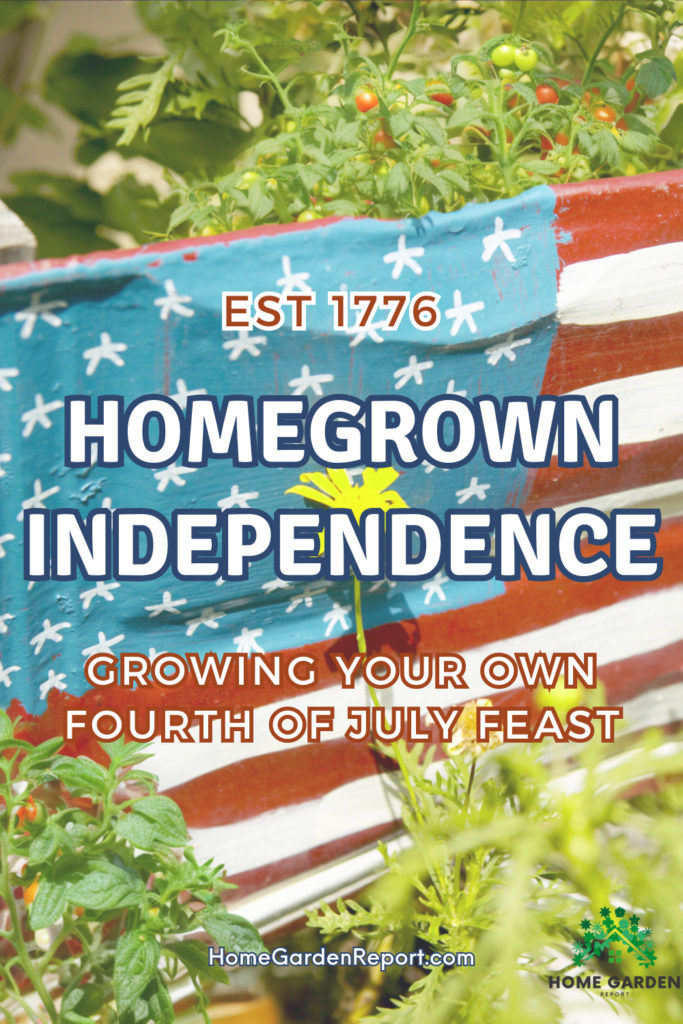
Welcome, fellow patriots and garden enthusiasts! Picture this: It’s the Fourth of July, the air is filled with the scent of barbecues and the sound of fireworks. You’re sitting down to a feast of fresh, delicious food. The sweet corn on the cob, juicy tomatoes, crisp cucumbers, and succulent berries didn’t come from a grocery store. No, they came straight from your backyard. This isn’t just any Independence Day feast; it’s a celebration of edible independence, a testament to your hard work, patience, and green thumb.
The spirit of Independence Day is deeply ingrained in our DNA as Americans. It’s a day when we celebrate our freedom, our resilience, and our ability to shape our own destiny. And what better way to embody these values than by growing our own food? It’s a pursuit that requires determination, self-reliance, and a connection with the land – values that are at the heart of the American spirit.
In this post, we’ll guide you through the process of planning, planting, and nurturing your garden so that come July 4th, you can enjoy a feast that’s truly homegrown. A feast that not only satisfies your taste buds but also reflects the spirit of independence and self-sufficiency that we celebrate on this day. So, let’s dig in and start our journey towards edible independence!
Why Grow Your Own Feast
As Americans, we cherish our independence and the ability to shape our own destiny. These values are deeply ingrained in our national identity, and they extend to every aspect of our lives, including the food we eat. Growing your own feast for Independence Day is not just about producing delicious, fresh food. It’s about embracing the spirit of self-reliance, sustainability, and connection with the land that our forefathers championed.
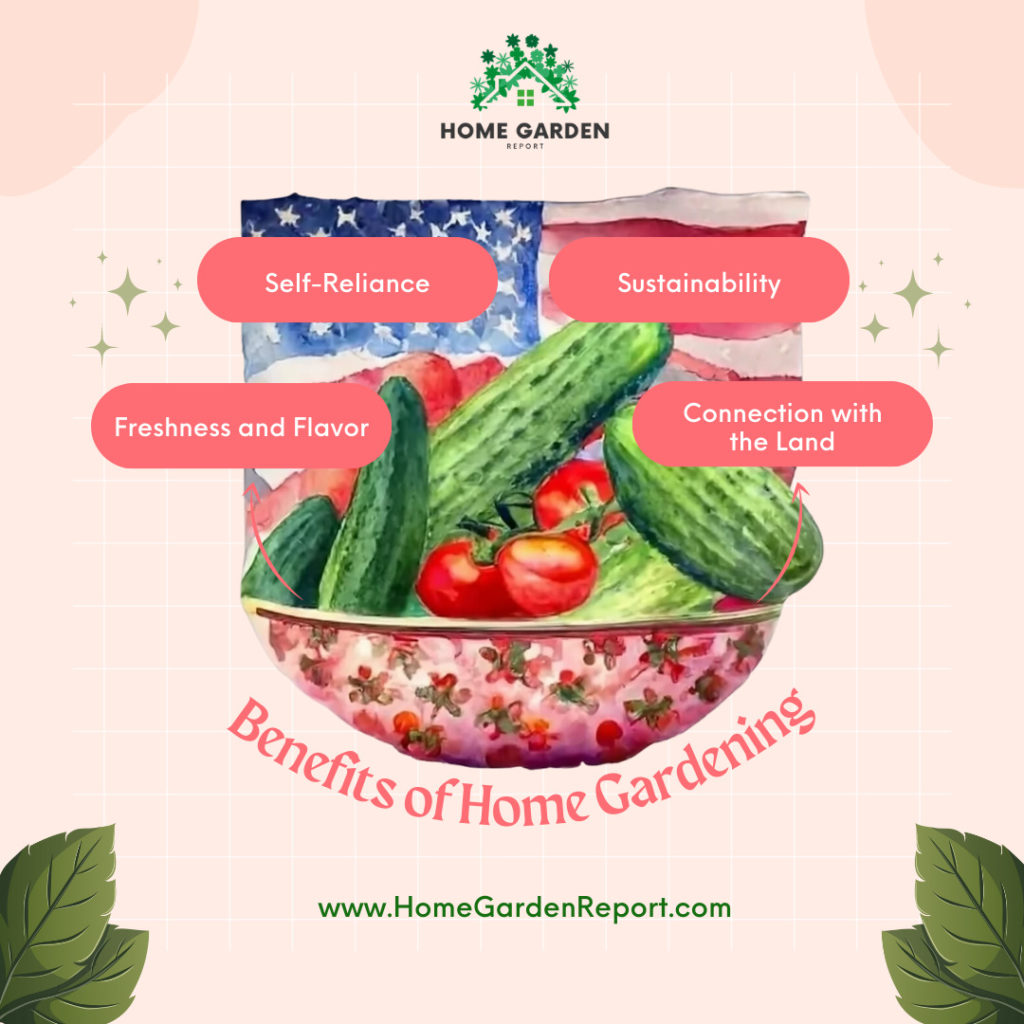
Freshness and Flavor:
There’s nothing quite like the taste of a tomato that’s been plucked straight from the vine or corn that’s been picked just hours before it hits your grill. When you grow your own food, you’re guaranteed the freshest, most flavorful ingredients for your July 4th feast.
Sustainability:
Home gardening is a sustainable practice that reduces your carbon footprint. It eliminates the need for transportation and packaging that comes with store-bought produce. Plus, it allows you to control what goes into your soil and onto your plants, ensuring that your food is free from harmful pesticides and chemicals.
Self-Reliance:
Growing your own food fosters a sense of self-reliance and independence. It’s a tangible way to take control of your food supply and know exactly where your food comes from. It’s a practice that echoes the pioneering spirit of our ancestors, who cultivated their own food and thrived off the land.
Connection with the Land:
Gardening deepens your connection with the land and the cycles of nature. It’s a rewarding experience to plant a seed, nurture it, and watch it grow into a plant that provides nourishing food. It’s a reminder of the simple yet profound cycle of life that sustains us all.
This Independence Day, let’s celebrate not just our national independence, but our edible independence as well. Let’s honor the land that nourishes us and the values that define us as a nation. Let’s grow our own July 4th feast!
Planning Your Garden
Just as our founding fathers planned and strategized for our nation’s independence, planning is a crucial step in your journey towards edible independence. A well-planned garden sets the stage for a bountiful harvest that will grace your Independence Day table.
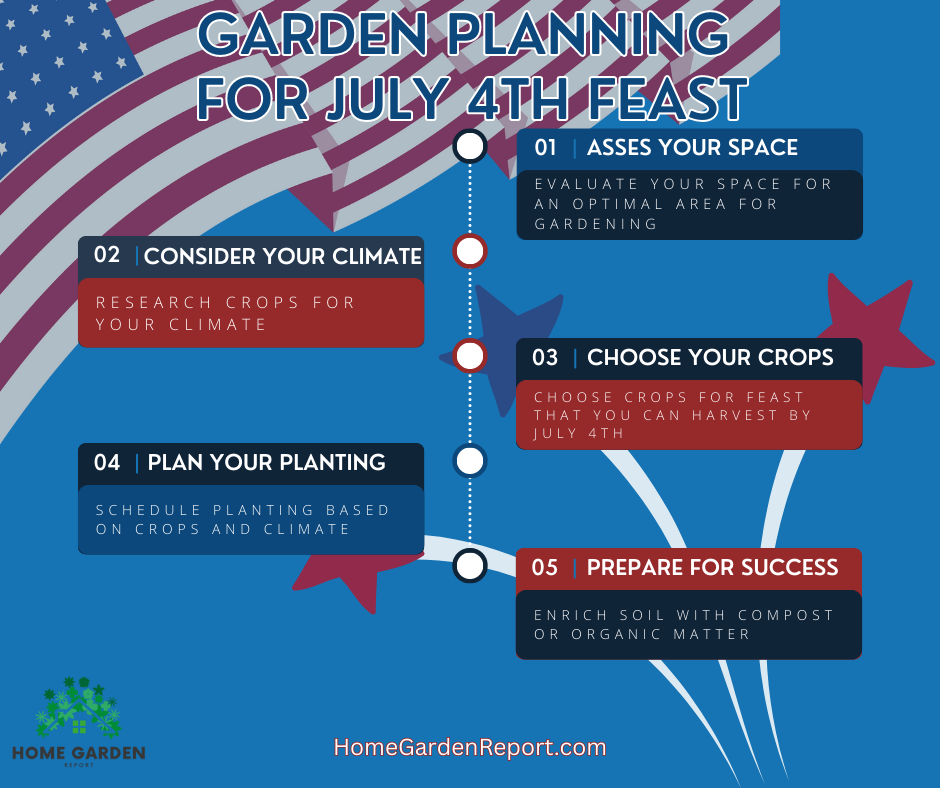
Assess Your Space:
The first step in planning your garden is to assess the space you have available. Whether you have a spacious backyard or a small balcony, you can grow a variety of crops. Remember, many vegetables like tomatoes, peppers, and herbs can be grown in containers if space is limited.
Consider Your Climate:
Different crops thrive in different climates. Research what crops grow best in your region and plan your garden accordingly. For example, if you live in a cooler climate, you might focus on crops like lettuce, peas, and radishes. If you live in a warmer climate, tomatoes, peppers, and cucumbers might be your go-to crops.
Choose Your Crops:
Think about what you’d like to serve at your July 4th feast and choose your crops accordingly. Corn, tomatoes, cucumbers, and berries are all excellent choices for a summer feast.
Plan Your Planting:
Once you’ve chosen your crops, it’s time to plan your planting. Most of the crops for your July 4th feast should be planted in the spring. However, the exact timing will depend on the specific crop and your local climate. Use a planting calendar for your region as a guide.
Prepare for Success:
Finally, prepare your garden for success by enriching your soil with compost or other organic matter. This will provide your plants with the nutrients they need to grow and produce a bountiful harvest.
Planning your garden may require some effort, but it’s an investment that will pay off when you’re enjoying fresh, homegrown food at your July 4th feast. So, grab your gardening gloves and let’s get planning!
Choosing the Right Crops
Choosing the right crops for your garden is like choosing the right words for the Declaration of Independence – it’s a crucial step that will shape the outcome of your endeavor. The right crops will not only thrive in your garden but will also make delicious additions to your July 4th feast.
| Crop | Zone 3 (North) Planting | Zone 3 Harvesting | Zone 6 (Mid) Planting | Zone 6 Harvesting | Zone 9 (South) Planting | Zone 9 Harvesting |
|---|---|---|---|---|---|---|
| Onions | April 1-15 | July 1-4 | March 15-30 | June 15-30 | February 1-15 | May 15-30 |
| Peas | April 1-15 | July 1-4 | March 15-30 | June 15-30 | February 1-15 | May 15-30 |
| Lettuce | April 1-15 | June 15-30 | March 1-15 | June 1-15 | January 15-30 | May 1-15 |
| Spinach | April 1-15 | June 15-30 | March 1-15 | June 1-15 | January 15-30 | May 1-15 |
| Potatoes | April 15-30 | July 1-4 | March 15-30 | June 15-30 | February 15-28 | June 1-15 |
| Carrots | April 15-30 | July 1-4 | March 15-30 | June 15-30 | February 15-28 | June 1-15 |
| Tomatoes | May 1-15 | July 1-4 | April 1-15 | June 15-30 | February 15-28 | June 1-15 |
| Cucumbers | May 1-15 | July 1-4 | April 1-15 | June 15-30 | February 15-28 | June 1-15 |
| Corn | May 15-30 | July 1-4 | April 15-30 | June 15-30 | March 1-15 | June 1-15 |
Tomatoes:
Nothing says summer like a ripe, juicy tomato. Tomatoes are perfect for salads, salsas, and even grilling. They require full sun and well-drained soil. Plant them in the spring after the last frost, and you’ll have tomatoes by July.
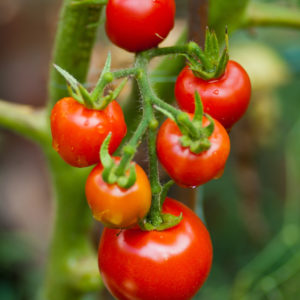
Growth Requirements:
Tomatoes require full sun and well-drained soil. They also need consistent watering and support for their vines.
Corn:
Corn on the cob is a classic July 4th dish. It’s a warm-season crop, so plant it when the soil temperature is above 60°F. With proper care, you’ll be enjoying fresh corn on the cob in time for your Independence Day feast.
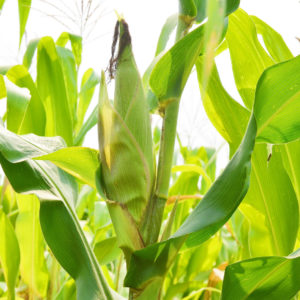
Growth Requirements:
Corn needs a sunny spot and fertile, well-drained soil. It also requires more space than other vegetables due to its height.
Cucumbers:
Cucumbers are a versatile crop that can be used in salads, pickled, or served as a refreshing snack. They love warm weather and need to be watered regularly. Plant them in the late spring, and you’ll have cucumbers by the summer.
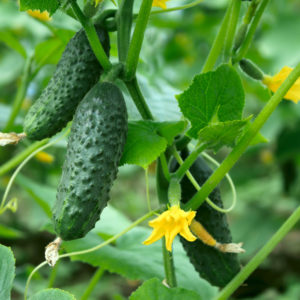
Growth Requirements:
Cucumbers love the sun and need plenty of space or a trellis to climb. They also require regular watering.
Berries:
Berries like strawberries, blueberries, and raspberries add a sweet touch to your July 4th feast. They can be used in desserts, salads, or eaten fresh. Berries require well-drained soil and plenty of sun. Some berries, like strawberries, can be planted in the spring and harvested in the summer.
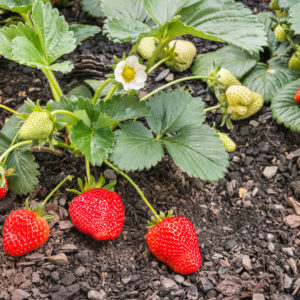
Growth Requirements:
Strawberries need full sun and prefer slightly acidic soil. They also require regular watering.
Choosing the right crops for your garden is a personal decision that depends on your taste, your garden conditions, and your culinary plans for the Fourth of July. But no matter what crops you choose, there’s nothing quite like the taste of homegrown produce. So, choose your crops, plant your seeds, and watch as your garden transforms into a source of edible independence!
Recipes for Your July 4th Feast
Now that we’ve chosen our crops and planned our garden, let’s turn our attention to the delicious dishes we can create for our July 4th feast. These recipes highlight the fresh flavors of homegrown produce and embody the spirit of Independence Day with a patriotic twist.
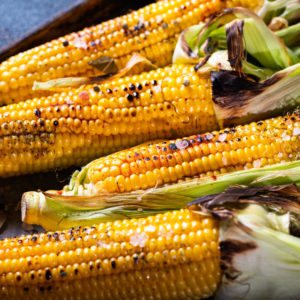
Grilled Corn on the Cob:
A classic July 4th dish, grilled corn on the cob is simple yet delicious. Simply peel back the husks without removing them, remove the silks, then brush the corn with butter, salt, and pepper. Pull the husks back up and grill for about 15 minutes. The result is sweet, smoky, and perfect for your Independence Day feast.
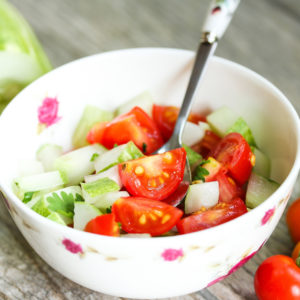
Fresh Tomato and Cucumber Salad:
This refreshing salad showcases the crispness of your homegrown cucumbers and the sweetness of your tomatoes. Slice your cucumbers and tomatoes, then toss them with olive oil, vinegar, salt, and pepper. Add some fresh basil leaves for an extra touch of summer flavor.

Patriotic Berry Parfait:
For dessert, create a patriotic berry parfait that’s as beautiful as it is delicious. Layer fresh strawberries and blueberries with whipped cream in a clear glass. The red, white, and blue layers make this dessert a patriotic tribute to Independence Day.
These recipes are just a starting point. Feel free to get creative and come up with your own dishes that highlight your homegrown produce. After all, part of the joy of growing your own food is getting to cook and share it with others. So, let’s get cooking and create a July 4th feast that’s truly homegrown!
Tips for a Successful Garden
Just as our founding fathers needed wisdom and perseverance to achieve independence, a successful garden requires knowledge, patience, and a bit of hard work. Here are some tips to help your garden thrive and ensure a bountiful harvest for your July 4th feast.
| Challenge | Solution |
|---|---|
| Poor soil quality | Enrich the soil with compost or organic matter. |
| Lack of sunlight | Choose plants that thrive in shade, or consider using grow lights. |
| Pests (insects, birds, rodents) | Use natural repellents, traps, or barriers. Consider attracting predators of the pests. |
| Weeds | Regularly weed your garden. Use mulch to suppress weed growth. |
| Overwatering or underwatering | Install a drip irrigation system for consistent watering. |
| Disease | Use disease-resistant plant varieties. Remove and dispose of diseased plants. |
| Limited space | Use vertical gardening techniques, or consider container gardening. |
| Unpredictable weather | Use protective covers to shield plants from extreme weather. |
| Lack of pollinators | Plant flowers to attract bees and other pollinators. |
Water Wisely:
Most vegetables aren’t too picky about when they get their water, but it’s best to water early in the morning to minimize evaporation. Avoid overwatering, as this can lead to root rot and other diseases.
Feed Your Plants:
Just like us, plants need nutrients to grow. Feed your plants with a balanced organic fertilizer to ensure they get all the nutrients they need. Remember, healthy plants are more likely to produce a bountiful harvest.
Keep an Eye Out for Pests:
Pests can be a major challenge in the garden. Keep an eye out for common pests like aphids, slugs, and beetles. If you spot them, use organic pest control methods to keep them in check.
Rotate Your Crops:
Crop rotation is a simple practice that can have a big impact on the health of your garden. By changing the location of your crops each year, you can help prevent the buildup of pests and diseases and improve soil fertility.
Be Patient:
Gardening is a process that requires patience. Just as George Washington demonstrated patience and strategic foresight during the battle for independence, so too must we be patient with our gardens. Don’t be discouraged if your plants don’t produce right away. With time, care, and a little bit of luck, you’ll be rewarded with a bountiful harvest.
Remember, every garden is unique, and what works for one gardener might not work for another. The most important tip is to keep learning, keep trying, and don’t be afraid to get your hands dirty. After all, the journey is just as important as the destination. So, let’s get gardening and work towards our edible independence!
Conclusion
As we’ve journeyed through the process of planning, planting, and nurturing our gardens, we’ve discovered that growing our own July 4th feast is about more than just producing delicious, fresh food. It’s about embracing the spirit of self-reliance, sustainability, and connection with the land that our forefathers championed. It’s about celebrating our edible independence.

Just as the seeds we plant in our gardens grow into nourishing food, the seeds of independence that our founding fathers planted have grown into a nation that values freedom, resilience, and the ability to shape our own destiny. This Independence Day, as we sit down to enjoy our homegrown feast, let’s take a moment to appreciate the journey from seed to harvest, from a dream of independence to a thriving nation.
Growing your own July 4th feast is a tangible way to connect with the land, honor our history, and celebrate our freedom. It’s a testament to the values that define us as a nation and a delicious way to celebrate our independence. So, let’s dig in, get our hands dirty, and cultivate our edible independence. Happy gardening and happy Independence Day!
Call to Action
Now that we’ve shared the joy and benefits of growing your own July 4th feast, we want to hear from you! Are you planning to plant a garden for your Independence Day celebration? Do you have any gardening tips or favorite summer recipes to share?
Join the conversation in the comments section below. Let’s share our experiences, our successes, and even our garden mishaps. After all, we’re all in this journey towards edible independence together.
And don’t forget to share this post with your friends and family. Encourage them to join you in growing their own July 4th feast. Let’s spread the spirit of edible independence far and wide!
Happy gardening, and here’s to a delicious, homegrown Independence Day feast!


